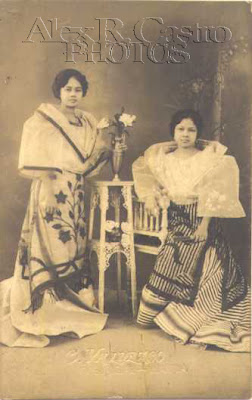
DRESSED TO THRILL. These prim and proper ladies from Tarlac knew how to flash their best fashions forward, in elegant baro’t saya that have been re-styled with angel sleeves derived from Victorian gowns, stiff triangular panuelos, sayang de kola (train) and elaborately-embroidered and tasseled wrapped around tapiz.
Kapampangan teeners’ idea of japorms at the turn of the century conformed strictly to the dressing tradition set in accord with your place in society. These ladies from Tarlac obviously belonged to the upper rung with their opulent baro’t saya and matching embroidered tapiz.
European fashion in the 1870s inspired the silhouette of the Philippine saya, slightly flaring with a long train (de kola) that one could tuck in front or swish about—although this may imperil other people! An American traveller, Le Roy by name, complained of one lady who “so swished her long calico train in front of a pony that was cantering up to the club with a carromata in which two of us were seated, that we were dumped out into a muddy rice field by the wayside”.
Common sayas were made usually of brightly colored abaca, woven with striped or checked patterns. Other materials like imported brocade, velvet silk and satin were the choices of ladies de buena familia. The colors of the saya were complemented with a tapiz wrapped tightly around the waist in solids or stripes.
The baro and panuelo, on the other hand, imitated the sloping shoulders and wide “angel sleeves” popular in the Victorian period. While sinamay was the standard material, baros and panuelos of the in-crowd were cut from the finest fabrics like jusi or sheer piña, delicately embroidered with the most wondrous patterns—flowers, butterflies, abstracts, art nouveau curlicues and even whole landscapes! In later years, the panuelo was reduced to a panuelito, small enough to hang folded on one shoulder. Apparently, the panuelito was a unisex accessory--the presidential 1st son, Mikey Arroyo, wore one over his shoulder at his wedding.
The baro of these ladies were of the mid 1900s versions, as theirs show signs of being stiffened with almirol or rice starch, to show off the fullness of their sleeves, a practice in vogue at that time. Their panuelos also follow the stiff triangular pattern to frame their lovely faces.
Long-haired girls often wore tortoiseshell peinetas embellished with seed pearls and chased gold. As a finishing touch, these smart dressers donned their best jewellery—gold tamborins on alfahor chains, devotional relicarios and criolla earrings probably ordered from nearby Meycauayan. A fan, perhaps, of ivory sticks, dangled from a gold chain abaniquera, ready to be fluttered when the going got hot. Though invisible from view, these girls most possibly wore low heeled corchos, silver-trimmed zapatillas or leather shoes custom-made by Pampanga’s premier shoemaker, Zapateria Moderna in San Fernando, established by Adriano Tuazon in 1907.
Long before Kapampangan teens became preoccupied with Nikes, Reeboks, Ralph Lauren, DKNYs, Abercrombies and Calvins, their young counterparts at the turn of the century certainly had the same flair for dressing, relying more on personal style, grooming and good taste rather than on labels and signature brands.
(7 June 2003)
European fashion in the 1870s inspired the silhouette of the Philippine saya, slightly flaring with a long train (de kola) that one could tuck in front or swish about—although this may imperil other people! An American traveller, Le Roy by name, complained of one lady who “so swished her long calico train in front of a pony that was cantering up to the club with a carromata in which two of us were seated, that we were dumped out into a muddy rice field by the wayside”.
Common sayas were made usually of brightly colored abaca, woven with striped or checked patterns. Other materials like imported brocade, velvet silk and satin were the choices of ladies de buena familia. The colors of the saya were complemented with a tapiz wrapped tightly around the waist in solids or stripes.
The baro and panuelo, on the other hand, imitated the sloping shoulders and wide “angel sleeves” popular in the Victorian period. While sinamay was the standard material, baros and panuelos of the in-crowd were cut from the finest fabrics like jusi or sheer piña, delicately embroidered with the most wondrous patterns—flowers, butterflies, abstracts, art nouveau curlicues and even whole landscapes! In later years, the panuelo was reduced to a panuelito, small enough to hang folded on one shoulder. Apparently, the panuelito was a unisex accessory--the presidential 1st son, Mikey Arroyo, wore one over his shoulder at his wedding.
The baro of these ladies were of the mid 1900s versions, as theirs show signs of being stiffened with almirol or rice starch, to show off the fullness of their sleeves, a practice in vogue at that time. Their panuelos also follow the stiff triangular pattern to frame their lovely faces.
Long-haired girls often wore tortoiseshell peinetas embellished with seed pearls and chased gold. As a finishing touch, these smart dressers donned their best jewellery—gold tamborins on alfahor chains, devotional relicarios and criolla earrings probably ordered from nearby Meycauayan. A fan, perhaps, of ivory sticks, dangled from a gold chain abaniquera, ready to be fluttered when the going got hot. Though invisible from view, these girls most possibly wore low heeled corchos, silver-trimmed zapatillas or leather shoes custom-made by Pampanga’s premier shoemaker, Zapateria Moderna in San Fernando, established by Adriano Tuazon in 1907.
Long before Kapampangan teens became preoccupied with Nikes, Reeboks, Ralph Lauren, DKNYs, Abercrombies and Calvins, their young counterparts at the turn of the century certainly had the same flair for dressing, relying more on personal style, grooming and good taste rather than on labels and signature brands.
(7 June 2003)








No comments:
Post a Comment